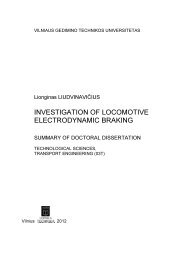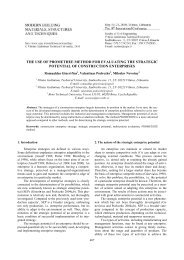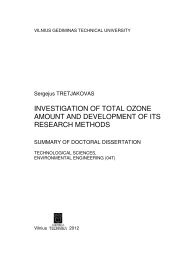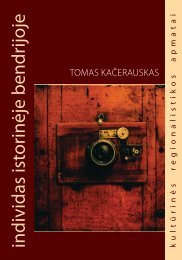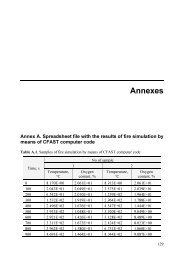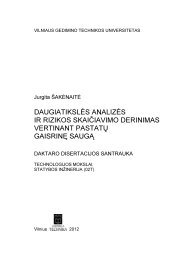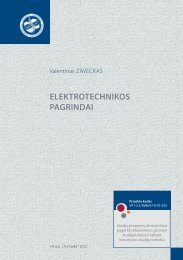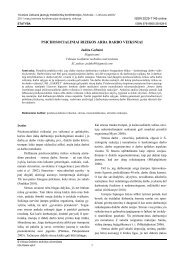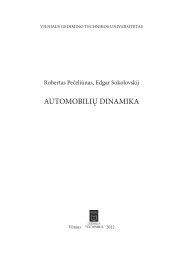improvement of diesel engine ecological parameters by using ...
improvement of diesel engine ecological parameters by using ...
improvement of diesel engine ecological parameters by using ...
You also want an ePaper? Increase the reach of your titles
YUMPU automatically turns print PDFs into web optimized ePapers that Google loves.
VILNIUS GEDIMINAS TECHNICAL UNIVERSITYJonas MATIJOŠIUSIMPROVEMENT OF DIESEL ENGINEECOLOGICAL PARAMETERS BY USINGBIOBUTANOL AND BIODIESEL MIXTURESSUMMARY OF DOCTORAL DISSERTATIONTECHNOLOGICAL SCIENCES,TRANSPORT ENGINEERING (03T)VILNIUS 2012
Doctoral dissertation was prepared at Vilnius Gediminas Technical Universityin 2007–2011.Scientific SupervisorAssoc Pr<strong>of</strong> Dr Sugirdas PUKALSKAS (Vilnius Gediminas TechnicalUniversity, Technological Sciences, Transport Engineering – 03T).The dissertation is being defended at the Council <strong>of</strong> Scientific Field <strong>of</strong>Transport Engineering at Vilnius Gediminas Technical University:ChairmanPr<strong>of</strong> Dr Habil Marijonas BOGDEVIČIUS (Vilnius GediminasTechnical University, Technological Sciences, Transport Engineering –03T).Members:Pr<strong>of</strong> Dr Žilvinas BAZARAS (Kaunas University <strong>of</strong> Technology,Technological Sciences, Transport Engineering – 03T),Pr<strong>of</strong> Dr Habil Sergejus LEBEDEVAS (Klaipėda University,Technological Sciences, Transport Engineering – 03T),Assoc Pr<strong>of</strong> Dr Stasys SLAVINSKAS (Aleksandras StulginskisUniversity, Technological Sciences, Transport Engineering – 03T),Dr Ádám TÖRÖK (Budapest University <strong>of</strong> Technology and Economics,Technological Sciences, Transport Engineering – 03T).Opponents:Pr<strong>of</strong> Dr Gvidonas LABECKAS (Aleksandras Stulginskis University,Technological Sciences, Transport Engineering – 03T),Dr Laurencas RASLAVIČIUS (Kaunas University <strong>of</strong> Technology,Technological Sciences, Transport Engineering – 03T).The dissertation will be defended at the public meeting <strong>of</strong> the Council <strong>of</strong>Scientific Field <strong>of</strong> Transport Engineering in the Senate Hall <strong>of</strong> VilniusGediminas Technical University at 10 a. m. on 3 February 2012.Address: Saulėtekio al. 11, LT-10223 Vilnius, Lithuania.Tel.: +370 5 274 4952, +370 5 274 4956; fax +370 5 270 0112;e-mail: doktor@vgtu.ltThe summary <strong>of</strong> the doctoral dissertation was distributed on 2 January 2012.A copy <strong>of</strong> the doctoral dissertation is available for review at the Library <strong>of</strong>Vilnius Gediminas Technical University (Saulėtekio al. 14, LT-10223 Vilnius,Lithuania).© Jonas Matijošius, 2012
VILNIAUS GEDIMINO TECHNIKOS UNIVERSITETASJonas MATIJOŠIUSDYZELINIO VARIKLIO EKOLOGINIŲRODIKLIŲ GERINIMAS NAUDOJANTBIOBUTANOLIO IR BIODYZELINO MIŠINIUSDAKTARO DISERTACIJOS SANTRAUKATECHNOLOGIJOS MOKSLAI,TRANSPORTO INŽINERIJA (03T)VILNIUS 2012
Disertacija rengta 2007–2011 metais Vilniaus Gedimino technikos universitete.Mokslinis vadovasdoc. dr. Saugirdas PUKALSKAS (Vilniaus Gedimino technikos universitetas,technologijos mokslai, transporto inžinerija – 03T).Disertacija ginama Vilniaus Gedimino technikos universiteto Transportoinžinerijos mokslo krypties disertacijos gynimo taryboje:Pirmininkaspr<strong>of</strong>. habil. dr. Marijonas BOGDEVIČIUS (Vilniaus Gediminotechnikos universitetas, technologijos mokslai, transporto inžinerija –03T).Nariai:pr<strong>of</strong>. dr. Žilvinas BAZARAS (Kauno technologijos universitetas,technologijos mokslai, transporto inžinerija – 03T),pr<strong>of</strong>. habil. dr. Sergejus LEBEDEVAS (Klaipėdos universitetas,technologijos mokslai, transporto inžinerija – 03T),doc. dr. Stasys SLAVINSKAS (Aleksandro Stulginskio universitetas,technologijos mokslai, transporto inžinerija – 03T),dr. Ádám TÖRÖK (Budapešto technologijos ir ekonomikos universitetas,technologijos mokslai, transporto inžinerija – 03T).Oponentai:pr<strong>of</strong>. dr. Gvidonas LABECKAS (Aleksandro Stulginskio universitetas,technologijos mokslai, transporto inžinerija – 03T),dr. Laurencas RASLAVIČIUS (Kauno technologijos universitetas,technologijos mokslai, transporto inžinerija – 03T).Disertacija bus ginama viešame Transporto inžinerijos mokslo kryptiesdisertacijos gynimo tarybos posedyje 2012 m. vasario 3 d. 10 val. VilniausGedimino technikos universiteto senato posėdžių salėje.Adresas: Saulėtekio al. 11, LT-10223 Vilnius, Lietuva.Tel.: +370 5 274 4952, +370 5 274 4956; fax +370 5 270 0112;el. paštas: doktor@vgtu.ltDisertacijos santrauka išsiuntinėta 2012 m. sausio 2 d.Disertaciją galima peržiūrėti Vilniaus Gedimino technikos universitetobibliotekoje (Saulėtekio al. 14, LT-10223 Vilnius, Lietuva).VGTU leidyklos TECHNIKA 1962-M mokslo literatūros knyga© Jonas, Matijošius, 2012
IntroductionTopicality <strong>of</strong> the problem. Internal combustion <strong>engine</strong>s, especially <strong>diesel</strong><strong>engine</strong>s, are one <strong>of</strong> the major sources <strong>of</strong> environment contamination. Whenburning petroleum fuels a large amount <strong>of</strong> harmful substances is released intothe air. One <strong>of</strong> the ways to avoid harmful environmental impact <strong>of</strong> exhaustgases and to overcome energy dependence on more and more expensive oiloriginfuel is <strong>using</strong> biobutanol and bio<strong>diesel</strong> (RME) mixtures.A new bi<strong>of</strong>uel mixture composed <strong>of</strong> biobutanol and bio<strong>diesel</strong> is beingused and tested. Scientific literature sources lack data on <strong>engine</strong> performanceand exhaust emission <strong>parameters</strong> measured when <strong>using</strong> these mixtures.Particular matter from internal combustion <strong>engine</strong>s, which consists <strong>of</strong>carbon, is usually covered with machine oil, fuel residues, sulphates, water,polar organic and non-organic materials, metals, etc.; carbonate aerosol isdescribed in literature sources. Its particles are actively studies in order todetermine their effect on climate change and human health. Stable isotope massspectrometry has been applied for study <strong>of</strong> aerosol particles since 1981, for thepurpose <strong>of</strong> establishing the origin <strong>of</strong> aerosol particles found in the atmosphere.Due to kinetic isotopic effect the ratio <strong>of</strong> 13 C/ 12 C carbon changes duringtransition from one environment to another (e.g. it differs in atmospheric air,trees, soil). Therefore, the ratio <strong>of</strong> stable carbon isotopes 13 C/ 12 C is one <strong>of</strong> themajor methods <strong>of</strong> establishing the origin <strong>of</strong> aerosol particles.Object <strong>of</strong> the research. The object <strong>of</strong> research there are <strong>ecological</strong><strong>parameters</strong> <strong>of</strong> a <strong>diesel</strong> <strong>engine</strong>, which are running on biobuthanol and bio<strong>diesel</strong>mixtures.Aim and tasks <strong>of</strong> the work. Aim <strong>of</strong> the work – the primary purpose <strong>of</strong> theresearch is to conduct theoretical and experimental studies and to substantiatethe possibilities <strong>of</strong> <strong>using</strong> bi<strong>of</strong>uel mixtures, composed <strong>of</strong> biobutanol andbio<strong>diesel</strong>, in a <strong>diesel</strong> <strong>engine</strong>, evaluating the <strong>engine</strong> performance efficiency,economic efficiency and <strong>ecological</strong> indicators.In order to achieve the purpose <strong>of</strong> the research the following objectivesneed to be accomplished:1. To examine physical and chemical characteristics <strong>of</strong> bio<strong>diesel</strong> andbiobutanol mixtures.2. To conduct an experimental study <strong>of</strong> <strong>ecological</strong>, power, fuelefficiency<strong>parameters</strong> <strong>of</strong> a <strong>diesel</strong> <strong>engine</strong> <strong>using</strong> biobutanol andbio<strong>diesel</strong> mixtures lieu mineral <strong>diesel</strong> fuel.5
3. To explore the properties <strong>of</strong> carbonate aerosols (PM), produced <strong>by</strong>burning <strong>of</strong> biobutanol and bio<strong>diesel</strong> mixtures, <strong>by</strong> applying stableisotope mass spectrometry and aerosol condensation methods.4. To evaluate the possibility <strong>of</strong> adapting methods, approved <strong>by</strong> otherauthors, <strong>ecological</strong> and thermodynamical <strong>parameters</strong> <strong>of</strong> themathematical model <strong>of</strong> a <strong>diesel</strong> <strong>engine</strong>.Methodology <strong>of</strong> research. Theoretical and experimental research methodswere applied in the thesis. The theoretical analysis performed is based onhydrodynamics, theoretical mechanics and the theory <strong>of</strong> combustion processdynamics, with application <strong>of</strong> analytical and digital research methods.Scientific novelty. The following new results in transport <strong>engine</strong>eringscience were obtained when preparing the doctoral thesis:1. The percentage amount <strong>of</strong> biobutanol in biobutanol and bio<strong>diesel</strong>mixtures which ensured physical and chemical properties <strong>of</strong> bi<strong>of</strong>uelmeeting the standard requirements and improved performanceefficiency and <strong>ecological</strong> <strong>parameters</strong> <strong>of</strong> a <strong>diesel</strong> <strong>engine</strong> wasestablished.2. It was established that in the case <strong>of</strong> <strong>using</strong> biobutanol and bio<strong>diesel</strong>mixtures the known methods <strong>of</strong> calculation <strong>of</strong> kinematic viscosity arenot absolutely precise.3. A mathematical model <strong>of</strong> <strong>using</strong> biobutanol and bio<strong>diesel</strong> mixtures,evaluating the performance efficiency and <strong>ecological</strong> <strong>parameters</strong> <strong>of</strong> a<strong>diesel</strong> <strong>engine</strong> running on these mixtures, was created.4. The carbon aerosol dispersity distribution and the total aerosol particleemissions from <strong>diesel</strong> <strong>engine</strong> <strong>using</strong> <strong>by</strong> Biobutanol and bio<strong>diesel</strong> blendswas sattled <strong>by</strong> particle stable mass spectrometry and aerosolconcentration methods. It is very important in determining <strong>engine</strong>exhaust effects and degree <strong>of</strong> hazard to human health.Practical value1. Performing test appointed that the maximum possible to 20 percentageamount <strong>of</strong> biobutanol in biobutanol and bio<strong>diesel</strong> mixtures whichensures meeting the fuel quality requirements and improvesperformance efficiency and <strong>ecological</strong> <strong>parameters</strong> <strong>of</strong> a <strong>diesel</strong> <strong>engine</strong>was established.2. There was proved that only biological-origin mixture was used and itsapplication in a <strong>diesel</strong> <strong>engine</strong> was substantiated – this allows tocompletely abandon mineral-origin fuel.6
3. It was noted during the process <strong>of</strong> calculation <strong>of</strong> kinematic viscositythat all the known methods <strong>of</strong> calculation <strong>of</strong> kinematic viscosity wasnot absolutely precise for calculation <strong>of</strong> bi<strong>of</strong>uel kinematic viscosity,which was due to low accuracy <strong>of</strong> calculations as compared withexperiment results.4. It was established that the dispersability properties <strong>of</strong> carbonateaerosols (PM) and aerosol particles total emission <strong>by</strong> applying stableisotope mass spectrometry and aerosol condensation methods.Defended propositions1. Performing test appointed that the maximum possible to 20 percentageamount <strong>of</strong> biobutanol in biobutanol and bio<strong>diesel</strong> mixtures whichensures meeting the fuel quality requirements and improvesperformance efficiency and <strong>ecological</strong> <strong>parameters</strong> <strong>of</strong> a <strong>diesel</strong> <strong>engine</strong>.2. Using biobutanol and bio<strong>diesel</strong> fuel mixtures can completely replacethe mineral-origin <strong>diesel</strong> fuel.3. The dispersability properties <strong>of</strong> carbonate aerosols (PM) and aerosolparticles total emission could be definite <strong>by</strong> applying stable isotopemass spectrometry and aerosol condensation methods.The scope <strong>of</strong> the scientific work. The thesis is presented in the Lithuanianlanguage. It consists <strong>of</strong> introduction, three chapters and the list <strong>of</strong> 150references. The thesis comprises 109 pages without the annexes, 9 tables,including 40 ilustrations.1. Analysis <strong>of</strong> Bi<strong>of</strong>uel Production and UseThe following issues are analyzed in this section: substantiation <strong>of</strong>feasibility <strong>of</strong> <strong>using</strong> bi<strong>of</strong>uel, based on scientific and legislative sources, thebi<strong>of</strong>uel resources available in the European Union and in Lithuania, application<strong>of</strong> butanol and bio<strong>diesel</strong> and their mixtures with mineral fuels in <strong>engine</strong>s,particulate matter exhausted <strong>by</strong> a <strong>diesel</strong> <strong>engine</strong> and the methods <strong>of</strong> its analysis,application <strong>of</strong> isotope mass spectrometry and other methods for analysis <strong>of</strong>internal combustion <strong>engine</strong> exhaust gases.2. Methodology <strong>of</strong> Biobutanol and Bio<strong>diesel</strong> Mixtures AnalysisThe analysis <strong>of</strong> physical and chemical properties <strong>of</strong> biobutanol andbio<strong>diesel</strong> mixtures was performed in the accredited Biocomponents ResearchLaboratory <strong>of</strong> Institute for Fuels and Renewable Energy (IPIEO).7
These were tested for bi<strong>of</strong>uels and their mixtures: Bio<strong>diesel</strong> – rapeseed oil fatty acid methyl ester (RME), derived fromrefined canola oil double its absolute methanol transesterification<strong>using</strong> an alkaline catalyst (KOH) method. Product line with theEuropean standard EN 14214:2001 requirements. Biobutanol – anhydrous n-butanol obtained in 96 % neutral butanol <strong>by</strong>distillation twice, plus 10 % CaCl 2 .There were evaluated for quality indicators in the studies: Density <strong>by</strong> EN ISO 12185. Viscosity <strong>by</strong> EN ISO 3104. Flash point <strong>by</strong> EN ISO 3679. Cetane number <strong>by</strong> EN ISO 5165. The amount <strong>of</strong> water <strong>by</strong> EN ISO 12937. Corrosion on copper plate <strong>by</strong> EN ISO 2106. Acidity <strong>by</strong> EN ISO 14104. Iodine number <strong>by</strong> EN ISO 14111. The cold filter plugging point, and calorific value <strong>by</strong> EN 116. Sulfur <strong>by</strong> EN ISO 20846. Monoaciloglycerol, diaciloglycerol, triaciloglycerol, free glycerol andtotal glycerol content in accordance <strong>by</strong> EN ISO 14105.For the purposes <strong>of</strong> theoretical studies <strong>of</strong> biobutanol and bio<strong>diesel</strong>mixtures, i.e. for modelling <strong>engine</strong> operation processes and emission <strong>of</strong>particulate matter and nitrogen oxides, an original mathematical model wascreated in the “Fortran 11” computer s<strong>of</strong>tware environment. Moreover,modelling computer s<strong>of</strong>tware “Diesel-RK 4.1.3.171” for simulating <strong>diesel</strong><strong>engine</strong> operation processes, which was designed <strong>by</strong> the scientists <strong>of</strong> MoscowState Techical University named after N. E. Bauman, was used for theabovementioned processes.Experimental tests <strong>of</strong> biobutanol and bio<strong>diesel</strong> <strong>engine</strong>s were conducted atInternal Combustion Engine Test Laboratory, located in Transport VehicleInstitute (IP) <strong>of</strong> Automobile and Machinery Faculty (SIMR) <strong>of</strong> WarsawUniversity <strong>of</strong> Technology. Experimental tests were performed on the basis <strong>of</strong>the international technical standard ICS 43.060 (Automobile <strong>engine</strong>s. Methods<strong>of</strong> bench tests). The following <strong>parameters</strong> were measured during the tests:torque Ms, pre-set fuel amount consumption time t, rated pressure p, excess-aircoefficient α, exhaust: CO, CO 2 , O 2 , CH, NO x , PM.For conducting experimental tests a laboratory test stand was created,which consists <strong>of</strong>: turbulent currents <strong>engine</strong> dynamometer, mounted togetherwith a <strong>diesel</strong> internal combustion <strong>engine</strong>, as well as exhaust and fuel8
consumption measuring equipment. The scheme <strong>of</strong> the test stand is presented inFig. 1.The analysis <strong>of</strong> exhaust gases <strong>of</strong> a <strong>diesel</strong> <strong>engine</strong> running on biobutanoland bio<strong>diesel</strong> fuel mixtures, employing the methods <strong>of</strong> stable isotope massspectrometry and aerosol condensation, was performed on 15–21 December2010 at Internal Combustion Engines Laboratory <strong>of</strong> the Department <strong>of</strong>Automobile Transport, which belongs to the Faculty <strong>of</strong> Transport EngineeringVilnius Gediminas <strong>of</strong> Technical University, in collaboration with the Nuclearand Radioactive Research Laboratory and Environmental Physics andChemistry Laboratory <strong>of</strong> the Physics Institute <strong>of</strong> the Centre for PhysicotechnologicalScience <strong>of</strong> the State Scientific Research Institute.The following equipment was used for the purposes <strong>of</strong> stable isotope massspectrometry and aerosol condensation tests: “Audi-80” 1Z type <strong>diesel</strong> internalcombustion <strong>engine</strong>, electric <strong>engine</strong> test stand КИ-5543 with a weightdynamometer, a stable isotope mass spectrometer “ThermoFinnigan Delta PlusAdvantage” with a connected burner “FlashEA 1112” and a condensationaerosol particle meter UF-02.Fig. 1. Laboratory test stand: 1 – fuel tank with the fuel used for tests, complete withthermometer; 2 – electronic chronometer “Sigma BC 400”; 3 – calibrated glass formeasuring the volume <strong>of</strong> the fuel consumed; 4 – turbulent currents <strong>engine</strong> dynamometer“SCHENCK WT190”; 5 – <strong>diesel</strong> internal combustion <strong>engine</strong> “Perkins 1104c-44”; 6 –<strong>engine</strong> exhaust gases’ smokiness measuring device AVL 415S; 7 – oxide analyser“Horiba 7170DEGR”; 8 – data registration device – portable computer “LENOVOT410”; 9 – power supply equipment; 10 – drawing ventilation9
3. Studies on Biobutanol and Bio<strong>diesel</strong> MixturesIt has been established during the tests that the following biobutanol andbio<strong>diesel</strong> mixtures complied with the quality requirements set out in regulatoryacts: with 10 % concentration <strong>of</strong> biobutanol (sample B) and with 20 %concentration <strong>of</strong> biobutanol (sample C). Pure bio<strong>diesel</strong> fuel (sample A) failed tocomply with only one parameter.Upon sample C reaching the threshold quantity <strong>of</strong> water (biobutanol isprone to absorbing water and increase <strong>of</strong> its concentration in a mixture resultsin an increase <strong>of</strong> the amount <strong>of</strong> water absorbed) and kinematic viscosity(biobutanol is more volatile than bio<strong>diesel</strong> and increase <strong>of</strong> its concentrationresults in decrease <strong>of</strong> density, as well as viscosity <strong>of</strong> the mixture), flashtemperature and cetane number (the increase <strong>of</strong> biobutanol concentration in amixture causes decrease <strong>of</strong> the mixture’s calorific capacity, it becomes morevolatile and thus evaporates and ignites more easily), acidity (potassiumchloride which is contained in biobutanol is prone to acidify the mixture andthis is increasingly more noticeable after increasing biobutanol concentration inthe mixture) reaching the threshold values no further tests based on physicaland chemical methodological guidelines for biobutanol and bio<strong>diesel</strong> mixtureswere conducted. Other physical and chemical <strong>parameters</strong> complied with therequirements set out in regulatory documents.It is feasible to continue further research tests with mixtures characterized<strong>by</strong> 10 % and 20 % biobutanol concentration in bio<strong>diesel</strong>.Kinematic viscosity determines not only fuel supply capacity, but alsooperation <strong>of</strong> fuel equipment and fuel spraying in the combustion chamber – thecourse <strong>of</strong> the whole operation process. Even though kinematic viscosity <strong>of</strong>biobutanol and bio<strong>diesel</strong> mixtures depends on kinematic viscosity <strong>of</strong> the initialsubstances, its calculation according to the additivity principle shall beinadequate.The most appropriate dependency (Fig. 2), meeting the experimentrequirements, was established.The most acceptable results are ensured <strong>by</strong> the dependancy proposed <strong>by</strong>Zdanovsky. The maximum inaccuracy <strong>of</strong> this dependency, when comparing thecalculation data with the experimental data, constitutes 17 percent, which isabsolutely unacceptable and the higher the concentration <strong>of</strong> biobutanol in themixture, the greater is this difference. For conducting further calculationscetane number <strong>of</strong> the mixtures was established according to the approximationdependency, which describes the experimental data.10
Fig. 2. Changes <strong>of</strong> biobutanol and bio<strong>diesel</strong> mixtures’ kinematic viscosityAs compared to the oil-origin fuel bio<strong>diesel</strong> is characterized <strong>by</strong> thefollowing ignition and combustion properties within an <strong>engine</strong> cylinder. Due toa higher cetane number (51 versus 40 <strong>of</strong> <strong>diesel</strong> fuel) the ignition delay period <strong>of</strong>bio<strong>diesel</strong> is shorter as compared to mineral <strong>diesel</strong> fuel. The evaporationtemperature (315 °C versus 250 °C <strong>of</strong> <strong>diesel</strong> fuel) determines the smalleramount <strong>of</strong> fuel prepared for combustion in a <strong>diesel</strong> <strong>engine</strong> cylinder during theignition delay period. As a result, there is a decrease <strong>of</strong> the heat amountreleased during the first kinetic phase <strong>of</strong> fuel combustion. On the other hand,the fuel combustion during the second combustion phase is becoming moreintense, which improves the energy <strong>parameters</strong>, primarily the rated efficiencycoefficient <strong>of</strong> the cycle, and decreases the concentration <strong>of</strong> incompletecombustion products (CO and PM) in exhaust gases. Up to the moment <strong>of</strong>achieving the maximum pressure <strong>of</strong> a cycle (p max ) the amount <strong>of</strong> the heatreleased is increasing as compared to the <strong>diesel</strong> fuel. As it is commonly known,the major part <strong>of</strong> NO x in a cylinder is formed before reaching p max , thus theemission <strong>of</strong> NO x when <strong>using</strong> bio<strong>diesel</strong> is increasing as compared to the cases <strong>of</strong><strong>using</strong> mineral <strong>diesel</strong> fuel. Alcohol (in our case biobutanol) additives tobio<strong>diesel</strong>, due to their lower cetane number and lower evaporation temperature(118 °C <strong>of</strong> biobutanol versus 315 °C <strong>of</strong> bio<strong>diesel</strong>) in general influence the shift<strong>of</strong> the combustion process to the exhaust stroke. Without essential change <strong>of</strong>the typical phases <strong>of</strong> the combustion process a high cycle efficiency coefficientis retained, in the meantime PM concentration decreases several times due to ahigher amount <strong>of</strong> oxygen in the elemental composition <strong>of</strong> alcohol (11.5 % <strong>of</strong>bio<strong>diesel</strong> versus 21.6 % <strong>of</strong> biobutanol). In case <strong>of</strong> a prolonged ignition delayperiod the use <strong>of</strong> alcohol can cause deviation <strong>of</strong> the work process <strong>parameters</strong>from the optimal condition. This may cause deterioration <strong>of</strong> the efficiencycoefficient and increase the emission <strong>of</strong> incomplete combustion products,11
mainly CO, in exhaust gases. In such case an optimization <strong>of</strong> the <strong>diesel</strong> <strong>engine</strong>adjustment <strong>parameters</strong> is required.These peculiarities related to the use <strong>of</strong> biobutanol and bio<strong>diesel</strong> mixturesin a <strong>diesel</strong> <strong>engine</strong> have to be considered during the analysis <strong>of</strong> experimentresults and conducting mathematical modelling research.Increase <strong>of</strong> biobutanol percentage in a mixture at an average <strong>engine</strong> rpmspeed (1400 min -1 ) extends the ignition delay period (Fig. 3), which increasesthe pressure increment rate during the second combustion phase and the <strong>engine</strong>is producing more noise. The maximum combustion pressure is achieved at anoptimum moment (12–13 ° after top dead centre, TDC) and little differs fromthe maximum combustion pressure developed <strong>by</strong> bio<strong>diesel</strong>.Increasing the <strong>engine</strong> rpm speed to 2200 min -1 (Fig. 3) and raisingconcentration <strong>of</strong> biobutanol in bio<strong>diesel</strong> results in a significant extension <strong>of</strong> theignition delay period in relation to the shaft rotation angle. The increment <strong>of</strong> thesecond combustion phase is also increasing, however the maximum combustionpressure is lower than that <strong>of</strong> bio<strong>diesel</strong> and the net efficiency coefficient isdecreasing.Upon comparison <strong>of</strong> the rated pressure (Fig. 3), measured during the use<strong>of</strong> biobutanol and bio<strong>diesel</strong> mixtures, a tendency <strong>of</strong> its reduction with theincrease <strong>of</strong> biobutanol concentration is observed. This fact can be explained interms <strong>of</strong> decreasing lower calorific capacity <strong>of</strong> the mixtures with the increase <strong>of</strong>biobutanol concentration.Fig. 3. Rated pressure is modeled for an <strong>engine</strong> running on biobutanol and bio<strong>diesel</strong>mixturesIn order to use biobutanol and bio<strong>diesel</strong> mixtures efficiently, the fuelsupply advance angle needs to be optimized, which would allow to shorten theignition delay period, to reduce the noise produced <strong>by</strong> the <strong>engine</strong> and wouldallow to achieve the maximum pressure in a cylinder at the right moment. Thiswould increase the mean effective pressure <strong>of</strong> an <strong>engine</strong>.12
Net efficiency coefficient is presented in Figure 4 a and b. It should benoted that it is the opposite <strong>of</strong> comparative fuel consumption and small lowercalorific capacity <strong>of</strong> the fuel. Taking this into account could explain theobtained values <strong>of</strong> the net efficiency coefficient. It was observed that theincrease <strong>of</strong> the amount <strong>of</strong> biobutanol in mixtures results in the increase <strong>of</strong> netefficiency coefficient, which is caused <strong>by</strong> physical and chemical properties <strong>of</strong>the fuel and the spraying quality at 1400 min -1 <strong>engine</strong> rpm speed. Whereasincrease <strong>of</strong> the <strong>engine</strong> rpm speed to 2200 min -1 causes decrease <strong>of</strong> netefficiency coefficient, which can be explained <strong>by</strong> the decreasing lower calorificcapacity. This corresponds to the statement <strong>of</strong> Rokopoulos, which claims thatthe bigger is the percentage <strong>of</strong> biobutanol additive in the mixtures, the leanerthey get and the greater is the temperature decrease in the cylinder.a) b)Fig. 4. Net efficiency coefficient: a) at constant <strong>engine</strong> rpm speed 1400 min -1 ;b) at constant <strong>engine</strong> rpm speed 2200 min -1An 11–22 % decrease <strong>of</strong> NO x concentration (Fig. 5) has been observedwhen <strong>using</strong> bio<strong>diesel</strong> and biobutanol mixtures in a <strong>diesel</strong> <strong>engine</strong> at 2200 min -1and 1400 min -1 rpm speed. Smaller NO x emissions <strong>of</strong> the <strong>engine</strong>s running onbiobutanol and bio<strong>diesel</strong> mixtures were observed and the emissions decreaseproportionally with the increase <strong>of</strong> biobutanol concentration in the mixtures.This is explained <strong>by</strong> the fact that the increasing biobutanol concentrationprogressively leans the mixture and decreases the temperature in the cylinder(due to decreased lower calorific capacity and higher vaporization heat <strong>of</strong>biobutanol). According to Corkwell, another significant factor is the lowercetane number (and this is the means <strong>of</strong> extending the ignition delay period).PM emission is presented in Figure 6. It should be highlighted thatcomparing with the starting point, the mineral <strong>diesel</strong> fuel, the amount <strong>of</strong> PMdecreased dramatically as opposed to both pure bio<strong>diesel</strong> fuel (<strong>by</strong> 53–73 %)and to biobutanol and bio<strong>diesel</strong> mixtures (<strong>by</strong> 71–76 % as compared to B20).13
a) b)Fig. 5. NO x gas emission: a) at constant <strong>engine</strong> rpm speed 1400 min -1 ;b) at constant <strong>engine</strong> rpm speed 2200 min -1This is attributed to the additional amount <strong>of</strong> oxygen in the mixtures.Increasing biobutanol concentration in bio<strong>diesel</strong> also results in decrease <strong>of</strong> PMemission, which could be explained <strong>by</strong> the fact that the shorter is thehydrocarbon molecule the better is its combustion and the lower C/H chemicalelemental ratio.a) b)Fig. 6. PM amount: a) at constant <strong>engine</strong> rpm speed 1400 min -1 ; b) at constant <strong>engine</strong>rpm speed 2200 min -1Aerosol particles, emitted in internal combustion <strong>engine</strong>, wereinvestigated <strong>by</strong> isotope ratio mass spectroscopy methods. Bio<strong>diesel</strong> andbio<strong>diesel</strong> with a butanol were used as a fuel. The purpose <strong>of</strong> these additionaldata was to evaluate experimentall, which fuel mixture types and at whichvehicle settings emit aerosol particles to the environment and at which extent.14
In addition to the total particle mass, aerosol mass in size segregatedaerosol particles (PM) were also measured.Highest aerosol particle mass concentration was measured in size rangefrom 0.18 to 0.32 µm, when B mixture was used. In the case with B20 mixture,highest aerosol particle concentration was in the size range from 0.056 to 0.1µm and from 0.18 to 0.56 µm (Fig. 7).Comparing amount <strong>of</strong> the emissions, bigger aerosol particle mass wasemitted <strong>using</strong> B fuel mixture (bio<strong>diesel</strong>). The amount <strong>of</strong> smallest aerosolparticles, which can easily penetrate to the human lungs, was comparable when<strong>using</strong> B or B20 mixture.Higher aerosol particle concentrations were measured in all particle sizes<strong>using</strong> B mixture. This shows that B20 mixture emit carbonaceous aerosolparticles at lower extent.In the aerosol particles size range from 0.056 to 1 µm organic carbon wasdominating, when used B and B20 mixtures. The amount <strong>of</strong> the elementalcarbon was 10 times smaller, comparing with the organic carbon in both cases(Fig. 7).C amount, µg140120100806040200Bio<strong>diesel</strong>TC koncEC koncOC concC amount, µg0,1 1 100,1 1 10D p, µmD p, µma) b)Fig. 7. Dependence <strong>of</strong> C amount on dispersive capacity <strong>of</strong> particles: a) <strong>using</strong>bio<strong>diesel</strong>, b) <strong>using</strong> B20 fuel mixture706050403020100TC koncEC koncOC concBio<strong>diesel</strong> 80%, biobutanol 20%The carbon isotopic ratio <strong>of</strong> the bio<strong>diesel</strong>, used in the experiment, wasδ 13 C=–30.54±0.44 ‰, for the biobutanol δ 13 C=–31.28±0.45 ‰. Fuel mixtureB20, composed <strong>of</strong> 80 % <strong>of</strong> bio<strong>diesel</strong> and 20 % <strong>of</strong> the biobutanol δ 13 C=–30.69(Fig. 8).Carbon isotopic ratio in the different size aerosol particles was rangingfrom –36 to –26 ‰. Isotopic pattern for the elemental carbon is different fromthe organic carbon. δ 13 C values for elemental carbon were about δ 13 C=–28 ‰,15
and was no difference between B and B20 fuel mixtures. Organic carbonisotopic values were changing depending on the aerosol size.δ 13 C, ‰-27 Bio<strong>diesel</strong>-28-29-30-31-32-33-34TCECOC0,1 1 10D p, µmδ 13 C, ‰-26-27-28-29-30-31-32-33-34-35-36-37Bio<strong>diesel</strong> 80%, biobutanol 20%TCECOC0,1 1 10D p, µma) b)Fig. 8. Dependence <strong>of</strong> δ 13 C on dispersive capacity <strong>of</strong> particles: a) <strong>using</strong> bio<strong>diesel</strong>, b)<strong>using</strong> B20 fuel mixtureThis can be related with the processes, involving particle grown duringcoagulation. For the estimation <strong>of</strong> the biobutanol influence to the new particleformation, biobutanol with different carbon isotopic ratio is needed. From thedifference <strong>of</strong> δ 13 C between initial fuel and exhaust particles is possible todetermine the effectiveness <strong>of</strong> the burning efficiency, because at bigger isotopicdifference indicate higher burning efficiency.Fig. 9. Dependence <strong>of</strong> aerosol particles concentration on the fuel type and <strong>engine</strong> loadConsidering the total concentration <strong>of</strong> the aerosol particles released(Fig. 9) it is apparent that the concentration <strong>of</strong> aerosol particles released <strong>by</strong> an<strong>engine</strong> running on mineral <strong>diesel</strong> fuel at 80 % <strong>of</strong> maximum <strong>engine</strong> load and <strong>of</strong>16
<strong>engine</strong> running on B and B10 fuel at maximum <strong>engine</strong> load was similar,however <strong>using</strong> B20 fuel caused a quite significant decrease (17 %) <strong>of</strong> aerosolparticles concentration. When the <strong>engine</strong> was running at 80 % <strong>of</strong> its maximumload the amount <strong>of</strong> aerosol particles remained unchanged regardless <strong>of</strong> the fuelused: B, B10 or B20.General Conclusions1. Performing physical and chemical tests appointed that the maximumpossible to 20 percentage amount <strong>of</strong> biobutanol in biobutanol andbio<strong>diesel</strong> mixtures which ensures meeting the fuel qualityrequirements and improves performance efficiency and <strong>ecological</strong><strong>parameters</strong> <strong>of</strong> a <strong>diesel</strong> <strong>engine</strong> was established.2. The analysis <strong>of</strong> kinematic viscosity methods revealed that neither <strong>of</strong>them can be applied for the purposes <strong>of</strong> the research <strong>of</strong> biobutanoland bio<strong>diesel</strong> mixtures.3. The experimental research <strong>of</strong> a <strong>diesel</strong> <strong>engine</strong> supplied withbiobutanol and bio<strong>diesel</strong> mixtures have been obtained:a) reduction <strong>of</strong> particle matter amount, carbon dioxide and nitric oxideappreciable emissions have been decreased in <strong>engine</strong> exhaustcompared with the <strong>engine</strong> operating in a pure mineral <strong>diesel</strong>. Butcarbon monoxide and unburned hydro carbonates have beenincreased;b) the appointed carbon particle size application <strong>of</strong> stable isotope massspectrometry and aerosol concentration methods has revealed a <strong>diesel</strong><strong>engine</strong> <strong>using</strong> pure <strong>diesel</strong>, B, B20 fuels. The kind <strong>of</strong> prevalence carbonhas been appointed too;c) depending on the concentration <strong>of</strong> biobutanol in bio<strong>diesel</strong> the netefficiency coefficient has been increased, but increasing <strong>of</strong> <strong>engine</strong>rpm speeds the effective efficiency coefficient has been decreased;4. Practical application <strong>of</strong> the mathematical model <strong>of</strong> a <strong>diesel</strong> <strong>engine</strong> tothe tests performed has established the following that withoutcomprehensive information on the initial characteristics <strong>of</strong> a <strong>diesel</strong><strong>engine</strong> the modelling results obtained were inconsistent with therated pressure and some <strong>of</strong> exhaust emissions experimental results.5. Further correction and modification <strong>of</strong> the model shall be mainlyrelated to the law <strong>of</strong> heat emission and calculation <strong>of</strong> energy<strong>parameters</strong> <strong>of</strong> bi<strong>of</strong>uel.17
List <strong>of</strong> Published Works on the Topic <strong>of</strong> the DissertationArticle in a scientific journalsMatijošius, J., Sokolovskij, E. 2009. Research into the quality <strong>of</strong> fuels and theirbiocomponents, Transport. Vol. 24, No. 3. p. 212–217 ISSN 1648-4142 (Thomson ISIWeb <strong>of</strong> Science)Mažeika, M., Matijošius, J., V. 2009. Naftos degalų ir etilo spirito mišiniais veikiančiovariklio darbo rodiklių tyrimas, Mokslas – Lietuvos ateitis = Science – future <strong>of</strong>Lithuania: Transporto inžinerija, T. 1, Nr. 6. 72–76 p. ISSN 2029-2341 (Scopus)Pukalskas, S., Matijošius, J., Žuraulis, V., Sadauskas, V. 2010. Šiuolaikinių dyzeliniųautomobilių variklių kietųjų dalelių filtrų regeneracijos problemos, Žemės ūkioinžinerija. Vol. 42, no 2–3. p. 196–203 ISSN 1392 -1134 (Scopus)Matijošius, J., Mažeika, M., Rimkus, A. 2010. Trikomponenčių degalų, biodyzelino irpropanolio, taikymas dyzeliniame variklyje, Mokslas – Lietuvos ateitis = Science –future <strong>of</strong> Lithuania: Statyba ir transportas, T. 2, Nr. 6. p. 77–80 ISSN 2029-2341(Scopus)Mažeika, M., Matijošius, J. 2010. Trikomponenčių degalų panaudщjimo galimybėsdyzeliniame variklyje, Žemės ūkio inžinerija. 2010, Vol. 42, No 2–3. p. 232–239ISSN 1392-1134 (Scopus)In the other editionsMatijošius, J., Mažeika, M., Pukalskas, S., K. 2009. Calculation methodology <strong>of</strong>working cycle <strong>parameters</strong> <strong>of</strong> the <strong>diesel</strong> <strong>engine</strong> operating on multicomponent mixture,RURAL DEVELOPMENT 2009: proceedings <strong>of</strong> the fourth international scientificconference [15–17 October, 2009], Lithuanian university <strong>of</strong> Agriculture / LatviaUniversity <strong>of</strong> Agriculture. p. 355–359 (ISI Proceedings).Matijošius, J., Sokolovskij, E., V. 2009. Research into the quality <strong>of</strong> biocomponents onthe fuel quality, TRANSBALTICA 2009: proceedings <strong>of</strong> the 6th International ScientificConference [April 22–23, 2009] / Vilnius Gediminas Technical University (VGTU)Transport Engineering Faculty <strong>of</strong> VGTU. p 147–151.Matijošius, J., Mažeika, M., K. 2009. Etanolio priedų, įtakojančių dyzelinio varikliodeginių kenksmingumą, tyrimas, Jaunimas siekia pažangos – 2009= Youth seeksprogress- 2009: Doktorantų mokslinės konferencijos straipsnių rinkinys / Lietuvosžemės ūkio universiteto doktorantų korporacija „Kolegos“. p 156–159.Matijošius, J., K. 2009. Sportinio automobilio su įmontuotu turbokompresoriumieksperimentiniai tyrimai, Jaunimas siekia pažangos – 2009= Youth seeks progress-2009: Doktorantų mokslinės konferencijos straipsnių rinkinys / Lietuvos žemės ūkiouniversiteto doktorantų korporacija „Kolegos“. p 191–194.18
Pukalskas, S., Matijošius, J., Rimkus, A., Bogdanovičius, Z., Kl. 2010. Mišrausbiodegalų tiekimo būdo panaudojimas, Technologijos mokslo darbai Vakarų LietuvojeVII: 7-oji mokslinė konferencija „Technologijos mokslo darbai Vakarų Lietuvoje“ 2010m. gegužės 14 d., Klaipėda/ Klaipėdos universitetas. ISSN 1822-4652 79 – p 86.About the authorJonas Matijošius was born in Vilnius, on 21 <strong>of</strong> August 1981.First degree in Mechanical Engineering, Faculty <strong>of</strong> MechanicalEngineering, Vilnius Gediminas Technical University, 2003. Master <strong>of</strong> Sciencein Mechanical Engineering, Faculty <strong>of</strong> Mechanical Engineering, VilniusGediminas Technical University, 2005. In 2007–2011 – PhD student <strong>of</strong> VilniusGediminas Technical University. Apprenticeships on the various scientificinstitutions in Poland (Warsaw University <strong>of</strong> Technology, Warsaw MilitaryAcademy, Institute <strong>of</strong> Fuel and Renewable Energy, Automobile Institute,Automotive Industry Institute) and Latvia (Riga Technical University). Atpresent – Lector in Automobile Transport Department <strong>of</strong> Vilnius GediminasTechnical University.DYZELINIO VARIKLIO EKOLOGINIŲ RODIKLIŲGERINIMAS NAUDOJANT BIOBUTANOLIO IRBIODYZELINO MIŠINIUSMokslo problemos aktualumas. Vidaus degimo varikliai, ypač dyzeliniai,yra vienas pagrindinių aplinkos taršos šaltinių. Deginant naftinius degalus įatmosferą išmetamas didelis kiekis žalingų medžiagų. Vienas iš būdų,padedančių išvengti žalingo naudotų dujų poveikio aplinkai ir atsisakytienergetinės priklausomybės nuo vis brangstančių naftinės kilmės degalų, yrabiobutanolio ir biodyzelino (RME) mišinių kaip degalų naudojimas.Disertacijoje tiriamas biodegalų mišinys, susidedantis iš biobutanolio irbiodyzelino. Duomenų apie deginių emisijos ir variklio darbo rodiklius,naudojant būtent minėtus mišinius, literatūros moksliniuose šaltiniuosenepakankama.Vidaus degimo variklių kietosios dalelės, kurias sudaro anglis, dažniausiaibūna „aplipusios“ tepalų, degalų likučiais, sulfatais, vandeniu, poliarinėmisorganinėmis ir neorganinėmis medžiagomis, metalais ir t. t., literatūrojeaprašomas karbonatinis aerozolis. Jo dalelės aktyviai tyrinėjamos dėl jųpoveikio klimato kaitai ir žmogaus sveikatai. Todėl stabiliųjų anglies izotopųsantykis 13 C/ 12 C yra vienas pagrindinių metodų aerozolio dalelių kilmeinustatyti.19
Tyrimų objektas. Darbo tyrimų objektas – biobutanolio ir biodyzelinomišiniais veikiančio dyzelinio variklio ekologiniai rodikliai.Darbo tikslas ir uždaviniai. Darbo tikslas – teoriškai ir eksperimentiškaiištirti bei pagrįsti biodegalų mišinių, susidedančių iš biobutanolio irbiodyzelino, dyzeliniame variklyje naudojimo galimybes, įvertinant varikliodarbo ekologinius, ekonominius ir efektyvumo rodiklius.Darbo tikslui pasiekti darbe reikia spręsti šiuos uždavinius:1. Ištirti biodyzelino ir biobutanolio mišinių fizinius ir cheminiusrodiklius, siekiant užtikrinti kokybės standartų reikalavimus,taikomus degalams ir biodegalams.2. Eksperimentiškai ištirti dyzelinio variklio ekologinius, darboefektyvumo ir energinius rodiklius, kai vietoje mineraliniodyzelino varikliui tiekiant biodegalų mišinius.3. Išmatuoti anglingo aerozolio (PM) dalelių koncentracijąskirtinguose dydžių intervaluose bei nustatyti bendrą išsiskiriančiųaerozolių dalelių koncentraciją dyzeliniame variklyje deginantbiobutanolio ir biodyzelino mišinius.4. Įvertinti galimybę pritaikyti pagal kitų autorių aprobuotasmetodikas sudarytą matematinį modelį dyzelinio variklioekologiniams ir termodinaminiems procesams nustatyti.Tyrimų metodika. Darbe taikyti teoriniai ir eksperimentiniai tyrimometodai. Atlikti teoriniai tyrimai yra pagrįsti hidrodinamikos, teorinėsmechanikos ir degimo proceso dinamikos teorija, pritaikius analitinius irskaitinius tyrimo metodus.Mokslinis naujumas1. Fiziniais, cheminiais ir analitiniais metodais nustatytasbiobutanolio procentinis kiekis biobutanolio ir biodyzelinomišiniuose, kuriam esant fizinės ir cheminės biodegalų savybėsatitiko standartų reikalavimus ir pagerino dyzelinio variklioekologinius parametrus.2. Anglingojo aerozolio dispersiškumo pasiskirstymui bei bendraiaerozolio dalelių emisijai nustatyti buvo panaudoti stabilių masiųspektrometrijos ir aerozolių koncentracijos metodai. Tai yra labaisvarbu nustatant variklio išmetamųjų dujų pavojingumo laipsnį beipoveikį žmonių sveikatai.20
3. Atliktas dyzelinių variklių dvizonio matematinio modelioekologinių rodiklių pritaikymas ir aprobavimas biobutanolio irbiodyzelino mišiniams.4. Nustatyta, kad dėl santykinai aukštos šaltojo filtro užsikimšimotemperatūros biobutanolio ir biodyzelino mišinius galima naudotišiltuoju ir pereinamuoju metų laikais.5. Nustatyta, kad naudojant biobutanolio ir biodyzelino mišiniusžinomos kinematinės klampos apskaičiavimo metodikos nėravisiškai tikslios.Praktinė vertė1. Nustatyta, kad maksimali biobutanolio koncentracija biobutanolio irbiodyzelino mišiniuose – 20 %, kuri atitinka degalų kokybei keliamusreikalavimus ir pagerina dyzelinio variklio ekologines charakteristikas.2. Įrodyta, kad dyzeliniame variklyje pritaikytas tik biologinės kilmėsdegalų mišinys ir tai leidžia visiškai atsisakyti mineralinės kilmėsdegalų.3. Skaičiuojant kinematinę klampą pastebėta, kad visos žinomoskinematinės klampos apskaičiavimo metodikos nėra visiškai tiksliosbiodegalų kinematinei klampai apskaičiuoti dėl didelės paklaidos tarpskaičiavimų ir eksperimentų rezultatų.4. Nustatyta, kad stabiliųjų izotopų masės spektrometrijos ir aerozoliųkoncentracijos metodais galima nusakyti anglingų aerozoliųpasiskirstymą pagal dispersiškumą, kas yra labai svarbu nusakant ypačmažų dalelių poveikį žmonių sveikatai, ir bendrą išsiskiriančiųaerozolio dalelių emisiją.Ginamieji teiginiai1. Atlikus fizinius ir cheminius tyrimus nustatyta, kad maksimalibiobutanolio koncentracija biobutanolio ir biodyzelino mišiniuose –20 % atitinka degalų kokybei keliamus reikalavimus ir pagerinadyzelinio variklio ekologines charakteristikas.2. Naudojant biobutanolio ir biodyzelino mišinius ir optimizuojantdegalų įpurškimo parametrus galima visiškai pakeisti mineralinėskilmės dyzeliną.3. Anglingojo aerozolio (PM) dispersiškumo pasiskirstymas bei bendrojiaerozolio dalelių emisija gali būti nustatoma taikant stabilių masiųizotopų ir aerozolių dalelių koncentracijos tyrimo metodus.21
Darbo apimtis. Darbą sudaro bendra darbo charakteristika, trys skyriai,išvados, literatūros sąrašas, publikacijų sąrašas ir priedai. Bendra disertacijosapimtis – 109 puslapiai be priedų, 40 iliustracijos, 9 lentelių ir 5 priedai.Pirmasis skyrius skirtas literatūros analizei, jame apžvelgti biodegalųvartojimą skatinantys veiksniai, butanolio ir biodyzelino naudojimo vidausdegimo varikliuose tyrimų rezultatai, dyzelinio variklio kietųjų dalelių poveikisaplinkai ir žmonių sveikatai, izotopų masės spektrometrijos ir kitų metodųtaikymas variklio išmetamosioms dujoms tirti. Skyriaus pabaigojeformuluojamos išvados ir tikslinami disertacijos uždaviniai.Antrajame skyriuje pateikiama biodyzelino ir biobutanolio mišinių tyrimometodika.Trečiajame skyriuje nustatoma biobutanolio ir biodyzelino mišinių sudėtis,atitinkanti degalams keliamus reikalavimams, nagrinėjami teoriniaibiobutanolio ir biodyzelino mišinių naudojimo dyzeliniuose varikliuoseaspektai, aprašomi biobutanolio ir biodyzelino mišinių eksperimentiniai tyrimųrezultatai.Bendrosios išvados1. Atlikus fizinius ir cheminius tyrimus nustatyta, kad maksimalibiobutanolio koncentracija biobutanolio ir biodyzelino mišiniuose –20 %. Tokio mišinio kokybės rodikliai atitiko dyzelino ir biodyzelinoapibrėžtus norminių aktų reikalavimus.2. Kinematinės klampos metodikų analizė parodė, kad dėl per dideliųpaklaidų, lyginant su eksperimento rezultatais, nė vienos iš jųnerekomenduojama taikyti biobutanolio ir biodyzelino mišiniųklampai nustatyti.3. Atlikus eksperimentinius dyzelinio variklio, veikiančio biobutanolioir biodyzelino mišiniais palyginamuosius tyrimus, nustatyta:a) kietųjų dalelių iki 82 %, anglies dvideginio iki 23 % ir azotooksidų iki 22 % kiekiai išmetamosiose variklio dujoseapčiuopamai mažėjo, lyginant su varikliu, veikiančiu grynumineraliniu dyzelinu, tačiau anglies viendeginio iki 30 % irangliavandenilių kiekiai iki 61 % – didėjo;b) pritaikius stabiliųjų izotopų masės spektrometrijos ir aerozoliokoncentracijos metodus nustatytas išmetamų anglies daleliųdydis, varikliui veikiant dyzelinu, B ir B20 degalais. Taip patnustatytas vyraujančios anglies pobūdis, naudojant skirtingusdegalų mišinius;c) efektinis naudingojo veikimo koeficientas gerėjo iki 4 %didinant biobutanolio kiekį biodyzeline, tačiau didinant varikliosūkius iki 2200 min -1 efektinis naudingojo veikimo koeficientas22
mažėjo iki 13 %.4. Skaičiuojamieji matematinio modeliavimo rezultatai parodė, kadtrūkstant išsamios informacijos apie dyzelinio variklio pradiniusduomenis gauti indikatorinio slėgio bei kai kurių teršalų emisijųmodeliavimo rezultatai neatitiko gautų eksperimento rezultatų.5. Ateityje planuojama įvertinti šilumos išsiskyrimo priklausomybių irbiodegalų energetinių parametrų įtaką skaičiuojamojo modeliotikslumui.Trumpos žinios apie autoriųJonas Matijošius gimė 1981 m. rugpjūčio 21 d. Vilniuje.2003 m. įgijo mechanikos inžinerijos bakalauro laipsnį Vilniaus Gediminotechnikos universiteto Mechanikos inžinerijos fakultete. 2005 m. įgijomechanikos inžinerijos mokslo magistro laipsnį Vilniaus Gedimino technikosuniversiteto Mechanikos inžinerijos fakultete. 2007–2011 m. – VilniausGedimino technikos universiteto doktorantas. Stažavosi įvairiose Lenkijos(Varšuvos technologijos universitete, Karinėje technikos akademijoje, Degalųir atsinaujinančios energetikos institute, Automobilių transporto institute,Pramoniniame motorizacijos institute) ir Latvijos (Rygos technikosuniversitetas) mokslo institucijose. Šiuo metu dirba lektoriumi VilniausGedimino technikos universiteto Automobilių transporto katedroje.23
Jonas MATIJOŠIUSIMPROVEMENT OF DIESEL ENGINE ECOLOGICAL PARAMETERS BYUSING BIOBUTANOL AND BIODIESEL MIXTURESSummary <strong>of</strong> Doctoral DissertationTechnological Sciences, Transport Engineering (03T)Jonas MATIJOŠIUSDYZELINIO VARIKLIO EKOLOGINIŲ RODIKLIŲ GERINIMAS NAUDOJANTBIOBUTANOLIO IR BIODYZELINO MIŠINIUSDaktaro disertacijos santraukaTechnologijos mokslai, transporto inžinerija (03T)2012 01 02. 1,5 sp. l. Tiražas 70 egz.Vilniaus Gedimino technikos universitetoleidykla „Technika“,Saulėtekio al. 11, 10223 Vilnius,http://leidykla.vgtu.ltSpausdino UAB „Ciklonas“J. Jasinskio g. 15, 01111 Vilnius



